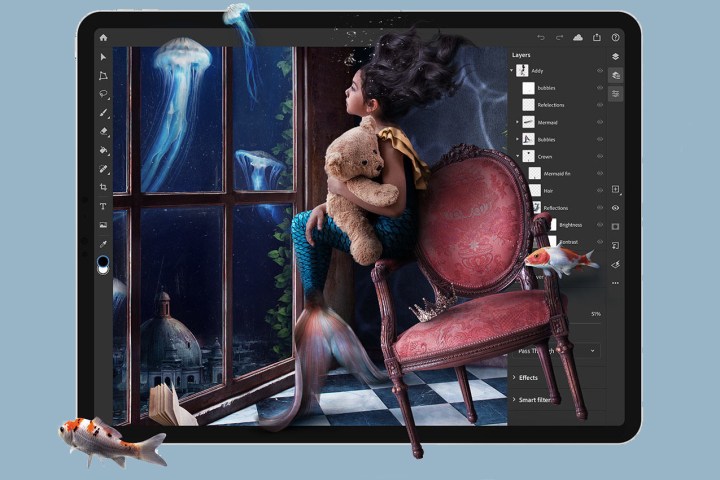
The most well-known photo editor is no longer chained to a desktop. On November 4, Adobe launched Photoshop for iPad, along with a list of updates to make the traditional Photoshop a bit less traditional, including a new Object Selection tool, one-click background removal, and updates to the interface. Adobe also announced Photoshop Camera for iOS and Android, and updates to Premiere Pro and Premiere Rush.
Photoshop for iPad
Teased last year during Adobe Max, Photoshop for iPad made its official debut at the start of this year’s event. While the goal is to eventually bring the same tools available for desktop to the iPad, as Adobe said last year, the first release of the iPad app is lighter than the robust desktop editor. Adobe says the first version focuses on composting, basic retouching, masking and the most commonly used Photoshop processes.
While the iPad version doesn’t have all the bells and whistles yet, Photoshop for iPad is built on the same code base as the original Photoshop, unlike Adobe’s previous Photoshop-inspired mobile apps like Photoshop Fix. Photo editors and designers can work with layers and more, and open the same PSD files in the desktop program.
The iPad app will autosave the PSD documents with a new Cloud documents expansion, allowing users to move from iPad to desktop without manually transferring files. If an internet connection is available, the updates are automatically synced between devices. (Only the autosave needs an internet connection, the app will work with or without a connection.)
Moving a desktop powerhouse to a smaller touchscreen device still means some major interface changes. The toolbox uses touch-friendly icons, but is still located on the left. Layers are also larger and touch-friendly, but still found on the right. A help icon in the right corner offers access to tutorials while adjusting to the new interface or trying Photoshop out for the first time on the iPad.
Photoshop for iPad doesn’t have all the features of the desktop software yet — Adobe says “new” features will be released as quickly as possible to close the gap between the two. The company says the initial launch will provide valuable feedback on how the app is used on the iPad that will help direct future updates.
Photoshop
The desktop Photoshop that photographers know and love isn’t going anywhere — but it is getting a few more features too. A new Object Selection Tool, recently teased by Adobe, uses artificial intelligence to select a single object. The new tool lives in the toolbox with the magic selection wand.
Object selection works much like Photoshop’s Select Subject, which is also getting a speed boost with the update. Rather than selecting the whole subject, the Object Selection Tool asks users to first draw a quick box around the object. That allows the A.I. to select one object that may not be the main subject, or maybe one of several subjects.
The Select Subject tool is also behind a new one-click background removal tool, which takes that automatic subject selection and removes the rest of the photo. The shortcut lives in a redesigned Properties panel, simplifying a common task in the photo editor.
Content-Aware Fill also has a few previously teased enhancements — photo editors can now use the traditional default, or draw a rectangle to indicate what pixels to use to fill in the gap. A new custom mode allows users to tell the program exactly what pixels to use to fill in the gap.
The update also has Photoshop looking a bit more modern. The Properties panel includes more tasks and details, eliminating the need to go into multiple panels. The top panel now includes document properties like canvas size and grids, layer properties like transform and align, and type properties like tracking and OpenType. The updated panel also houses a shortcut to select the subject and that new background removal tool.
The gradients and patterns no longer look like the bright and outdated Word Art, with new gradients based on color families with a more subtle, natural look. (If you prefer the traditional, bright options, they’re still available as legacy presets). Gradients can also now be simply dragged and dropped onto the canvas to apply them. Presets can be organized into groups, with live previews of the end result available just by scrolling through the preset options.
Additional updates include the ability to use depth maps from compatible cameras to selectively apply lens blur, more flexibility in the transform tool, a new shortcut to convert a Smart Object to layers, new keyboard shortcuts, and adjustment layers for 32-bit images.
Like Photoshop for iPad, Document cloud support can also autosave your work and make files sync across devices. Similar to Creative Cloud libraries, Document Cloud counts towards the storage limits, but is designed for single files rather than large volumes.
Photoshop for iPad is included with any existing Adobe Creative Cloud subscriptions that include the desktop Photoshop, as well as new subscribers. Photoshop for iPad is available from the app store, with subscription plans available directly from Adobe.



